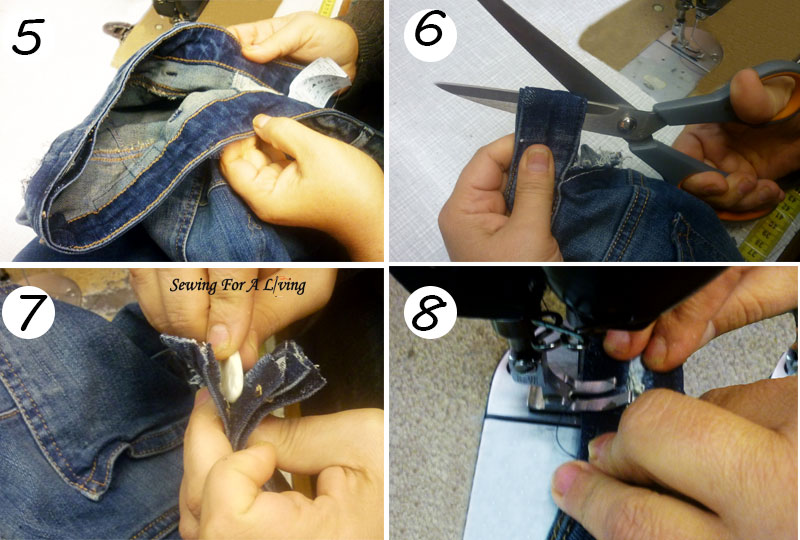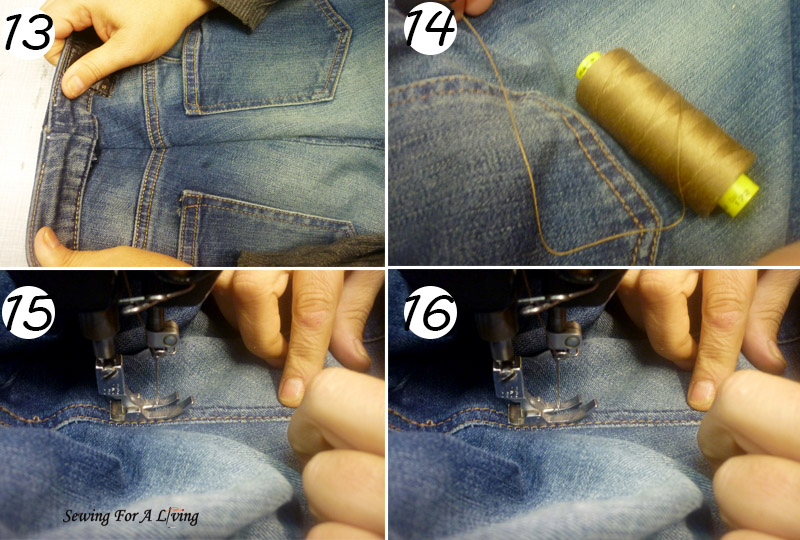Taking in the waist of jeans and pants is probably the most requested alteration in our studio. The other one, believe it or not, is upsizing the waist. I fix most of mine, too. If this is something you would like to learn how to do, let me show you my favorite way to take in the waist of jeans and pants.
There are different ways to approach this alteration. For example, if it is a pattern that goes well with darts, you can increase the size of the darts and do some adjustments to the waistband.
When I work with jeans, I prefer to take in the waist on the back seam.
That way the end result looks very much like the original. I made two different video tutorials to show how I take in the waist – one on jeans and one on man’s shorts that have the waist manufactured similar to dress pants.
I would suggest you watch them both to get a perspective on how you can approach this project. If you prefer the written instructions, scroll down to the bottom of this page.
How To Take In The Waist Of Jeans Video
How To Take In The Waist Of Pants Video
Like what you read here? Support my site
If you want to help me continue delivering similar content, please consider buying me a coffee to keep it going. It really helps me focus and have more time to prepare these tutorials and develop my lessons.
I can devote more time and do everything involved to make this happen and share with you what I’ve learned about sewing and pattern making.
I would really appreciate it.
How to take in the waist on jeans step-by-step
You are going to need:
- scissors;
- measure tape;
- pins;
- chalk or a sliver of soap;
- thread ripper;
- sewing machine;
- overlocker sewing machine or a zig-zag stitch
- matching jean thread.
The steps to take:
First, I measure how much I need to take in while the person is wearing the jeans.
I pay attention to two things: how much the waist is to be taken in and also how low I need to go on the back seam. Sometimes the problem is just on the waistband, sometimes it goes to the yoke or even down through all the back seam length. I put on pins to mark it. The pins should replicate the shape we aim to achieve when the alteration is done (picture 1).

The next step is to draw with a piece of chalk on the inside of the jeans, replicating the position of the pins (picture 2). Doing this allows us to remove the pins so we can work on that area. The marks we made point out where the stitching line is going to be.
I keep the pins on one side so they can mark the stitching line (picture 3). This is not a must, but it helps if for any reason the chalk marks disappear while I am still working on the jeans.
Then,
remove the back loop on the waistband and the seams on the waistline band, just a couple of stitches more than the area we are about to work on (picture 4).
The next step is to remove both top stitches on the back seam.
I usually do this almost up to the crotch line (picture 4), so the joining of the stitches won’t be too visible.
Sometimes those seams might be holding the two back pieces together so the jeans get separated on the back seam. In our case, I cut the excess fabric with scissors, leaving enough for the seam allowance, and then just join the two pieces together with those two parallel top stitches.
In our case, those two stitches are just top stitches, not joining seams. So, we remove them in order to be able to work under them.
Start working on the waistband.
I hold both side seams of the jeans so I can determine where exactly is the center of the waist (picture 5).
It is very important to cut exactly at the middle of the waistband (picture 6).

I transfer the marks for the stitching line on all of the four pieces that the waist consists of. I am being careful to transfer them even, so the jeans are joined exactly in the middle (picture 7).
Then,
I stitch the waist back together at the line where the pins used to be (picture 8). I do this on both the inner and outer pieces of the waistband.
Take in the rest of the back side of the jeans.
Now we have a waistband that is smaller than the rest of the jeans in the area of the yoke (picture 9).

Cut out the excess fabric on the waistband so it doesn’t bulk up and look unnatural (picture 10). Make a straight seam exactly on the stitching line that we marked with the chalk to show the amount of excess fabric (picture 11).
I don’t separate the two back pieces of the jeans, I sew on top of the existing stitches. This excludes the need to be careful to match the pieces of the yoke as they are already matched. I make sure to anchor the stitches at the end.
At this stage, you can have the client or yourself (if the pair is yours) try and see if the jeans fit fine before you cut the excess fabric. I usually skip this step, as I am sure I measured precisely. You might do it if the gap between the waist and the hips is too big and makes a strange curve, or if you simply feel uncertain about how you’ve done by far.
If everything seems fine, let’s cut the excess fabric (picture 12).
I used the scissors for the waist, making sure to leave some allowance (approximately 1 cm/or 3/8 of an inch). That way the waistband won’t unravel (picture 10).
I use the overlocker/ serger to cut and clean the edges up to the point where we finished taking in. If you don’t own an overlocker, it is perfectly fine to use the scissors for cutting here too and clean the edges of the denim fabric with zig-zag stitching, so it wouldn’t fray.
The last step is to make the top stitches.
We’ve taken in the waistband and the back seam (picture 13). The last thing we need to do is to make the top stitches. We start by choosing the appropriate color of thread (picture 14).

The best match you make, the best results you are going to get. I have literally hundreds of colors and shades, but it often happens that I don’t own the exact match. This is another reason that breaking the original stitching near the crotch is a good idea.
If the color of the thread doesn’t match exactly, it won’t be that visible.
We repeat the original stitching as it was before, having in mind to anchor at both ends (pictures 15 and 16).
Last, top stitch the waistband.
We must do the same with the waistband. We put the allowance we left inside in both directions so it is even and doesn’t get too thick on one side only (page 17). Repeat the stitches as they used to be, again anchoring at the beginning and the end (pictures 18 and 19).

The last step is to put the belt loop back on at its original place.

Here we go, now the pair of jeans fit perfectly. If you have any questions or suggestions, please leave me a comment below. I would be happy to help in any way I can.

Thank you for such an understandable tutorial. I have a pair of reversible jeans that I need to take in at the waist. I suppose you would describe these more like jeggings. Will this work for those? Thanks in advance for your reply.
It very much depends on the way they are made. If they look like those I’m showing in the video or the ones in the written instructions, you most certainly can.
I hope this helps!
Thank you for the easy to understand tutorial! I’ve always shied away from taking in my jeans because it seemed too complicated to move everything around, but it never occurred to me to take it in from the back seam. I’ve always had to size up for my hips and thighs, and just cinch the heck out of the waist with a belt… but this looks so much easier!
good tutorial. I have taken up waistlines but making a slit on the inside of the band at right and left seams and inserted a piece of elastic. It does leave a small stitch line for the elastic but sometimes you don’t have to take up very much.
I wish that we lived next door to each other. I’m going to give it a shot when I have a little bit more time. You explained everything great. The cutting of the yoke might be a little difficult, but I’m going to give it my best. Thankyou for all of your time I really appreciate everything you did to show me and every one else. Thankyou, Linda
Thank you!
Thank you very much Daniela. Your instructions are very clear and also very helpful! This is an alteration job that I have avoided doing but feel confident now that I’ve seen your tutorial.
I’m glad to hear the tutorial was helpful, Connie. Just try to do it, there’s nothing to be nervous about.
I honor your thorough review and the time for putting this. It looks very professional to me, and I really don’t know much on working with clothes but I only wish others would understand their niche as much as you do. It will significantly help those who are struggling with taking in the waist of jeans 🙂
Thank you Alexey, I try to do my best to help those who try to learn.
Greetings!